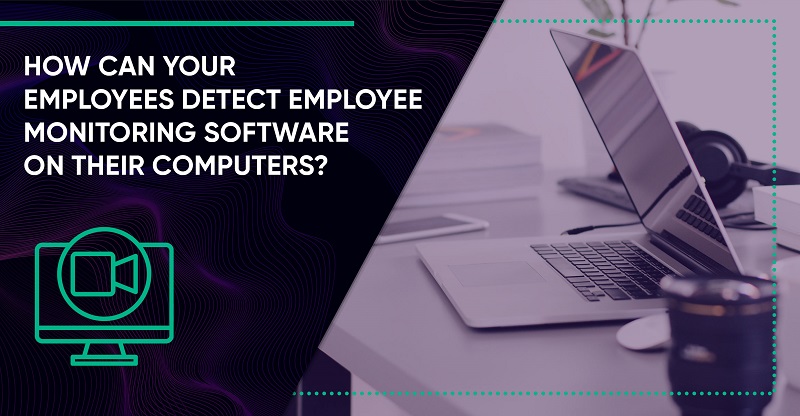We highly recommend that any employer who is considering implementing employee monitoring software in their company read this article, in which we discuss the topic of using employee monitoring solutions in stealth mode, some ways your employees can find out if their computers are being monitored, and the proper approach to introducing employee monitoring software in the company.
Employee monitoring has been a widely growing practice for quite some time now. Businesses turn to digital monitoring tools to track their employees’ work engagement and overall performance. There’s been a steady surge in monitoring methods that help employers measure their specialists’ productivity, track their attendance and assess behavior as well as ensure company data security.
So today, after receiving numerous requests from our users, we’re going to take a closer look at whether it’s possible for your employees to detect monitoring software as well as provide some tips on the correct introduction of employee monitoring solutions.
What Are the Benefits of Implementing Employee Monitoring Software?
No one can argue with the fact that employee monitoring software is changing the way business owners keep up to date with what’s happening in their companies. 81% of employers report that implementing monitoring software has boosted employee productivity. Automated monitoring solutions help to measure employee productivity, track their working time, and keep track of everything that happens in the company in the time between formal meetings.
Tracking employees’ time and engagement can benefit companies in a number of ways, which include:
- improving employee productivity. By tracking the work employees do, employers can determine whether the work of the specialists is up to the company standards. If the standards aren’t met, managers can determine the ways to help their team members to improve their work;
- identifying bottlenecks and internal problems. Tracking the productivity of individual employees as well as entire teams in general helps managers to understand the struggles and problems that their team members might be facing at work. Monitoring the productivity and the time it takes employees to complete certain tasks helps to identify those workers who take longer than expected to complete a task;
- improving the engagement of remote employees. Luckily for companies with remote employees, monitoring has never been easier with advanced remote monitoring solutions that are now available on the market. Such employee monitoring software enable work from home without sacrificing remote specialists’ visibility to the managers;
- increasing company data security. Visibility into how employees are handling sensitive company data is simply essential for keeping such data safe from insider threats, especially in a remote or hybrid work environment.
If you’d like to delve deeper into this subject, we already have a dedicated in-depth article about the pros and cons of implementing employee monitoring software for you to get acquainted with.
Can Your Employees Determine if Their Work PCs Are Monitored?
Of course, there are cases when you’d prefer to install employee monitoring software in a stealth mode (for example, if you suspect someone on your team is trying to slack off or even leak company sensitive information to the competitors).
Yet there are some employees who are just nosey and might feel the desire to know everything that’s happening in the company (even if they have no need or access to certain information).
Let’s imagine a situation when a curious employee of yours spent numerous hours on Reddit to figure out how to detect employee monitoring software running on their PC. They might’ve simply googles something along the lines of, “How to Tell if Your Employer Is Monitoring Your Computer”
First advice they could see would probably be about checking the list of the installed applications and identifying suspicious third-party software. At the same time, when the system administrator embeds employee activity monitoring software, there’s a chance it won’t be displayed as an installed app.
Here are some digital strategies your employees might turn to in order to find out whether they have monitoring software installed on their computers.
Method 1. Searching in Task Manager
First things first, your inquiring employees might check for any unusual background operations. They could open Task Manager by pressing the coveted three keys Ctrl+Alt+Del and look for any apps in either Processes or Services tab that might raise their suspicions. Then, with any questionable apps they manage to identify, they’ll simply do a quick google search and find out the details about each one of them.
However, you should keep in mind that your specialists won't be able to access Task Manager and therefore check for suspicious apps simply if they don’t have admin rights on their work PC. And even if they do, this method is quite time-consuming and strenuous.
What’s more, certain employee monitoring tools, such as Kickidler, for example, have a stealth installation mode and therefore won't be visible in Task Manager. Besides, any skilled system administrator knows how to disguise such software as a system process or service.
Method 2. Running the Command Line
To determine if they have an unfamiliar app that might be monitoring their PC activities, your snoopy specialists might also want to check their device’s data usage, having assumed that a monitoring solution would connect to the internet in order to send the data regarding their activities to their management.
By running the command line as Administrator, entering the command [netstat -b -n] in the opened window and looking through the list of applications, the employees might find out what applications on their PCs transmit data on the internet.
Once again, if the employee doesn't have admin rights, this method won't suit them. It’s also out of the question if they are on a local network.
Plus an experienced system administrator would still be able to disguise the software easily even then.
Method 3. Downloading anti-spyware software
Another proven method of detecting spyware is through installation of some kind of dedicated anti-spyware or other antivirus software, such as Emsisoft Emergency Kit free antivirus scanner that is run from a flash drive.
Common antivirus tools also have the ability to detect monitoring software, but admins usually classify agents of such software as exceptions. So corporate antivirus will probably not be of any help to those of your employees who want to detect monitoring software running on their PCs. It will, however, notify you as a supervisor of any attempts of your employees to run third-party software on the company's hardware.
Besides, many employee monitoring solutions do not operate at the user or system level, which means employees once again won't be able to detect them that way.
Method 4. Monitoring outgoing traffic
While traffic monitoring could be considered the safest and most reliable method, it is also not without its flaws.
There are free traffic monitoring software available for installation, such as Glasswire, that allow users to see all the outgoing traffic on their computers. However, while some tools for monitoring employees continuously transmit data to the server, others might transmit data only at designated times, for example, at night. So this approach is also a tad unpredictable.
And yet again, in order to download such traffic monitoring applications, employees will need admin rights.
Method 5. Turning to social engineering
If your especially nosey employees are willing to waste substantial amount of time and effort in order to confirm (or deny) their suspicions, they might try to approach people who might be related to employee monitoring practices. For example, they might try to establish a rapport with a tech specialist who could be directly involved in its implementation or an HR manager who could be reviewing such automated reports on employee productivity.
Other, less effective ways for employees to detect employee monitoring solutions on their computers are also worth mentioning. These ways might include checking what apps have access to webcam, looking through the Program Files folder or going through antivirus software exclusions. However, in most cases employees will need corresponding access rights for any of those approaches to work.
How to Introduce Employee Monitoring Software The Correct Way?
The question that might arise next is, “How exactly do I implement employee monitoring software the proper way?” While all the knowledge can easily seem overwhelming at a first glance, there are some practices you might choose to follow in order to streamline the process of introducing employee monitoring solution:
- Check the relevant laws. Seeing how employee monitoring regulations can vary from country to country, be sure to look into all the applicable laws before making the final decision of monitoring your employees. This is especially important when you choose to implement monitoring methods for a globally-distributed team of remote employees. And don’t forget to update your policies on the regular basis when there are any changes in the legislature.
- Choose an employee-friendly tool. When implementing employee monitoring solution, try and make sure that it’s as transparent as possible. Avoid using monitoring tools that secretly monitor the staff members, since this can lead to decreased employee trust and also set you up for legal issues. Explain to your employees all the benefits they themselves will experience from the implementation of such software.
- Be transparent about the monitoring. Finally, while it’s not mandatory to inform your employees of certain monitoring measures, it’s always a good idea to be transparent about them. We also recommended that you obtain their written consent regarding the monitoring methods you’ll be using. Inform your employees through a notice about what data you will be tracking and your reasons for that. This way, your people will have a better idea of the reasoning behind your decision and will be more open to it. Moreover, it will promote workplace fairness at your company.
How to Prevent Employees from Detecting Monitoring Software?
Still, if your situation implies the need to implement monitoring solution in stealth mode, we recommend you follow this simple advice:
- Limit the number of people who have administrator rights (so that your ordinary employees who will be monitored don’t go snooping around in system folders and Task Manager).
- Do not implement covert monitoring on personal devices.
- Do not approve of third-party software download on work PCs in your company.
- Sign necessary NDAs with the employees who will be aware of the monitoring.
Here are some final thoughts for you to consider. We always recommend for our users to install Kickidler openly and preface its use with signing the corresponding agreement with the employees whose work computer activity will be monitored.
However, once again, we do realize that there might be different situations when you might feel the need to turn to covert monitoring. And we’re proud to note for such cases that our software is the hardest one for employees to detect.
If the need arises for you to deploy Kickidler in a stealth mode, such option can be chosen during the initial setup. Kickidler transmits data to the server continuously and not in certain times of day, so the employees won’t notice any suspicious data usage or background processes.

 ENG
ENG 
